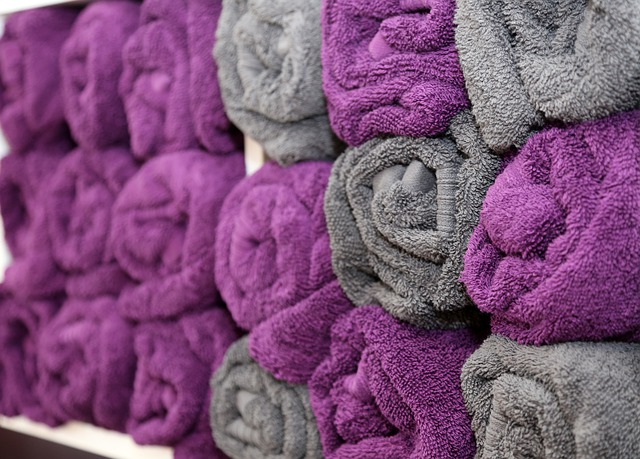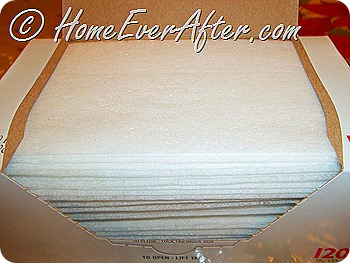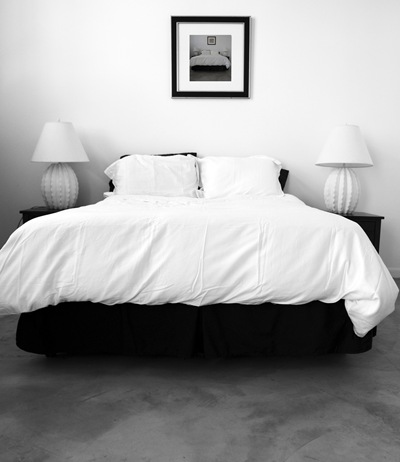13 Ways to Save Money on Laundry Costs

While we can’t eliminate laundry from your list of necessary housework items, we can help you save money on laundry with these frugal laundry tips.
Laundry can be as expensive or as inexpensive as you want it to be, depending on what measures you take to cut the costs. Not all tips are right for every family; just choose the ones you can work into your current system today and enjoy lower utility and laundry supply bills!
Here are 13 different ways to save on the cost of doing laundry, ranging from quick and easy to long-term solutions.
13 Ways to Save Money on Laundry Costs
1. Buy Energy Star rated appliances. That Energy Star emblem means they use less energy in a more efficient manner and will cost you less to use. When replacing old or worn out appliances, check first for the Energy Star on your replacement choices.
2. Cut dryer sheets in half. One box lasts twice as long when you cut the sheets in half. As soon as you open the box, break out the scissors and enjoy cutting your dryer sheet expenses by 50%! I also sometimes cut them in thirds. Surprise! They still work just as well and we never have a static cling problem.
3. Dilute laundry detergent in the bottle with water. Save your empty laundry detergent bottles. When you open a fresh one, pour half into the empty bottle. You now have 2 bottles half full of detergent waiting to be filled with water. You can fill water all the way to the top or 2/3 full, depending on the savings you want. Diluted detergent will get your clothing just as clean, and if you’re used to filling the cap (or your family members are), this trick will save you.
Most of us use more detergent than recommended or necessary anyway. Don’t believe me? I did the experiment and have the numbers to prove it! Read The Truth About Your Laundry Cap.
4. Use less detergent and liquid fabric softener. Are you strong enough to skip the diluting and just use less? More power to you!
5. Clean the lint trap before every load of laundry. A clean lint trap lets your dryer work more efficiently and dry clothes faster. Spend the extra 20 seconds and empty it before you start the dryer. Plus, a clean lint trap cuts down the risk of a dryer fire – how about that!
6. Line dry your clothes. String up a line, buy some cheap wooden clothes pins, and you’re in business. Zero energy use and it costs exactly $0 to use.
7. Create a hybrid drying routine. Maybe you don’t like line drying because of the possible clothing stiffness. Maybe you can’t use a clothesline because of space limitations, like living in an apartment with no yard. If you can’t convert wholly to the clothesline method for whatever reason, create a hybrid routine that still has you using your electric dryer, but only half as much. Hang items to dry over shower curtain rods, hang from ceiling fans, or clotheslines for part of the time, dryer for the rest. Get soft clothes with half the energy use.
8. Do less laundry. Wear jeans more than once, use bath towels more than once. Sweaters and jackets can also be worn more than once if you wear them layered with a shirt underneath. Make sure you hang up clothes that can be worn again so that they’re not washed by mistake.
9. Double up 1/2 loads of laundry and only dry full loads. Put your half load of washed whites in the dryer and let them wait until your next half load is complete. Dry as one full load and cut the energy cost in half.
10. Dry loads back to back if possible to keep the dryer from cooling down and having to heat up again (save time and energy).
11. Double spin clothes in the washer. After your washing machine is done, turn the knob to “Spin only” and spin the clothes a second time. The centrifugal motion (spinning) helps to get extra water out of the clothes, which in turn take less time to dry in the dryer.
12. Use vinegar in the wash instead of fabric softener (1/4 cup). Smaller loads need smaller amounts, unless you want to smell vinegar on your clean clothes! This cheap alternative to liquid fabric softener will save money on your laundry supply budget for certain.
13. Wash in the coldest temperature recommended for your clothes. Save your water heater from firing up to heat the water when possible. Cold wash temperatures will also help to preserve the fibers in the material of your clothing, meaning it won’t wear out as fast.
Frugal challenge: Choose a few of these great money-saving frugal laundry tips today, and see how much you can drive down your laundry expenses!
Originally published June 26, 2008.





23 Comments
CL
WASH your lint filter! I thought our dryer needed replacing because it took longer and longer to dry the same old clothes. I scrubbed the filter with a drop of dish soap and a nail brush, rinsed really well, let air dry, and popped it back in. Cut drying time by more than half! Fabric softener and dryer sheets both cause build-up that clogs the filter, impeding air-flow and extending drying time.
Pingback:
Home Ever After
@CL: Awesome tip on washing the lint filter! Very good info which I’ll be adding to laundry articles in the future. Thank you.
@WhatEver Page: Thanks for the link love!
Homemaker Barbi
Momma @ 3princessesmomma.com
We cut our laundry costs down to nothing by taking 15 minutes every 3 weeks to make our own laundry detergent. It’s cheap, easy, and leaves your clothes far cleaner and fresher than regular laundry detergent. I have a recipe for it on my website, if anyone is interested.
We’ve been using the vinegar in place of fabric softener ever since the article I read about how Downy’s primary ingredient is animal fat. Great post 🙂 It’s nice to see that there are plenty of alternatives to saving money, even on things like the landry.
Home Ever After
@Momma:
Thanks for sharing your story. Would you mind linking to the detergent recipe in the comments? I’d love to see the ingredients, and I think the rest of the readers would too.
Barbi
Pingback:
Jenna @ Newlyweds
Great ideas, I have even gone so far as making my own laundry detergent!
Lauri
instead of dryer sheets I take celluose sponges cut them into quarter size and soak them into a cup of liquid fabric softener then squeeze out then toss into dryer with my clothes
shay
i wish i could use these tips but live in apartment and often have to go to the laundry mat and pay to wash. i do my delicates at home by hand though to save a little.
Home Ever After
@Lauri- that is a great alternative for dryer sheets.
Barbi
Danielle
Great list, I never thought of washing the lint trap! One thing I would suggest is when you use vinegar in the wash don’t put it in until the rinse cylce. Vinegar is known to breakdown laundry detergent!
Rikki
I use about 1/2 c baking soda in each full load and only 1/3 the detergent and bleach recommended. The baking soda boost detergents and bleaches (chlorine and non) and removes nasty odors!
CraftTeaLady
Put up a clothes line. That will save significantly on the electric cost for the drying cycle. I don’t like towels out there (they get ‘crunchy’ but everything else does great and is never wrinkled). 🙂
Laura H
Toss a clean, dry towel in with each dryer load. Your clothes will dry much, much faster.
Shelley
I also use baking soda mixed with water in the softener container of my washer- works great. Be careful about drying clothes on your shower rod- one time I hung a pair of wet jeans up there in my old apartment and got rust stains on them!
Pingback:
Super Amazing Savings
Love the tips. I use a few of these already. I cut my dryer sheets in half, I use 1/2 the cup of detergent and I try to run the dryer back to back. It does make a huge difference.
Teresa at MomsWhoSave.com
I just did a post about homemade laundry detergent on my blog. I had been thinking about it forever, and finally decided to try it–I don’t regret it. Below is the post with the recipe for the powdered detergent I’m using, although there are lots of recipes out there.
Laurel
I have done a lot of these when I had my own washer and dryer! When you use a laundromat, you aren’t able to use the spin cycle a second time around!
Corey
Spin dryers such as at http://www.laundry-alternative.com are 100 times as energy efficient as conventional clothes dryers. You can save over $100 per year and they are gentler on the clothes, so your clothes will last longer. They can work with a clothesline as well, for example when it’s damp/rainy outside.